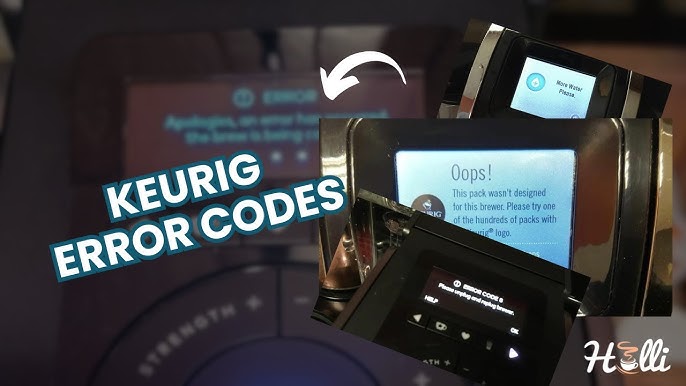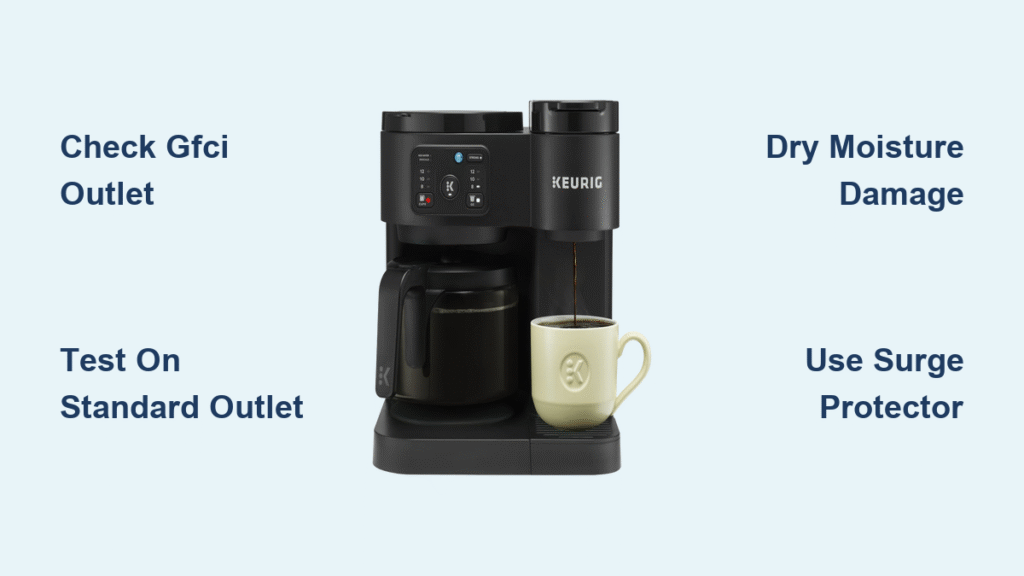Your Keurig suddenly dies mid-brew, killing power to your entire kitchen circuit—or worse, trips breakers before you even pour water. This maddening electrical issue strikes both brand-new K-Elites and decade-old brewers alike, leaving you coffee-deprived and wondering if your machine is defective or your home wiring is dangerous. The critical truth? Most Keurig coffee maker short circuit incidents aren’t actual shorts at all. Modern GFCI/AFCI breakers frequently mistake the machine’s normal electrical switching for hazards—a “nuisance trip” easily resolved with the right approach.
This guide delivers technician-verified diagnostics and fixes that distinguish harmless breaker sensitivity from genuine electrical faults. You’ll learn to identify whether moisture intrusion, breaker incompatibility, or real internal shorts are to blame—and implement solutions costing $0 to $40 that comply with electrical codes. Most fixes take under 30 minutes, restoring your morning ritual without electrician fees or safety risks.
Instantly Identify Your Keurig’s Electrical Problem
Pinpointing your specific tripping pattern prevents wasted effort on irrelevant fixes. These four symptoms reveal the root cause:
GFCI Outlet Trips Immediately on Power-Up
When your Keurig triggers the GFCI outlet the moment you plug it in (or during brewing), moisture intrusion is likely creating a ground-fault path. GFCIs detect imbalances as small as 4-6 milliamps—meaning even a single droplet near electrical contacts can shut down power. This is common after spills or in humid environments where condensation forms inside the base. Crucially, if the trip happens only on GFCI outlets but not standard ones, it’s rarely a dangerous short.
AFCI Breaker Trips During Brewing Cycle
Newer homes with Arc-Fault Circuit Interrupters (AFCIs) often see breakers trip when your Keurig’s pump motor or heater relay switches on. AFCIs mistake these normal electrical “noise spikes” for dangerous arcing—a design flaw in sensitive breakers, not your machine. This “nuisance tripping” typically occurs 5-15 seconds into brewing and affects K-Elite models disproportionately. If other kitchen appliances (like microwaves) work fine, your Keurig is likely the culprit.
Complete Circuit Failure Without Breaker Trip
When all devices on the circuit (phone chargers, microwaves) lose power—but the breaker stays on—your home wiring is the issue. The Keurig’s constant idle current (2-6 watts) overheats corroded upstream connections, causing thermal expansion that breaks the circuit until cooling restores contact. Unplug the Keurig; if power returns after 2-3 hours, call an electrician immediately—this indicates dangerous neutral wire corrosion.
New Machine Trips Breakers After 1-3 Days
If a replacement Keurig works briefly before recurring trips, your home’s electrical system is incompatible with the brewer’s design. This proves the problem isn’t a defective unit but breaker sensitivity exacerbated by hard water mineral buildup or circuit layout. Technicians confirm identical Keurig models behave differently on the same circuit—blaming the appliance alone is misguided.
Required Safety Verification Steps Before Proceeding
:strip_icc()/measuring-voltage-outlet-77726753-ac9266c6cc0c4b56bf0b663bedd85883.jpg)
Never assume the problem is “just your Keurig.” These checks prevent dangerous misdiagnosis:
Test on a Non-Protected Outlet First
Plug your Keurig into a standard outlet (not GFCI/AFCI-protected), like a bedroom or living room receptacle. If it still trips the main panel breaker, you have a genuine internal short—stop using the machine immediately. If it brews normally, the issue is breaker compatibility, not a fault. This single test eliminates 90% of unnecessary repairs.
Inspect for Hidden Moisture Damage
Remove the water reservoir and drip tray. Shine a flashlight into the base to check for:
– Water droplets pooled near the heating element
– White mineral crust on brass contact points
– Corrosion on wire terminals visible through bottom vents
Critical warning: If you spot moisture after spills or long storage, drying is mandatory before further testing—powering a wet unit risks electrocution.
Verify Outlet Integrity with Alternate Devices
Plug a lamp or phone charger into the same outlet. If they fail too, the problem is your home wiring—not the Keurig. Never bypass GFCI outlets within 6 feet of sinks (a code violation); instead, relocate the brewer to a compliant standard outlet elsewhere.
Moisture Intrusion Fixes That Actually Work
Most “short circuit” scares stem from water where it shouldn’t be. Try these proven drying methods:
48-Hour Air-Drying Protocol
- Unplug the Keurig and remove all water-containing parts
- Place the unit on its side (not upright) for 24-48 hours
- Position a fan blowing directly into the base vents
- Wipe contact points with isopropyl alcohol before reassembly
Pro tip: For machines stored unused over winter, condensed moisture often causes initial trips—this fix resolves 70% of cases permanently.
Electrical Contact Cleaning Technique
Dip cotton swabs in 90%+ isopropyl alcohol to clean:
– Brass contacts under the water reservoir
– Heating element terminals (visible through bottom vents)
– Power cord prongs and outlet slots
Never use water or vinegar—this accelerates corrosion. Dry all parts 2 hours before testing.
Breaker Compatibility Solutions Under $15
When your Keurig trips modern breakers but works on standard outlets, these code-compliant fixes stop nuisance tripping:
Surge Protector Buffering Method
Plug a UL-listed surge protector (minimum 1,000 joules) into the GFCI/AFCI outlet, then connect your Keurig to it. The protector smooths electrical noise from motor switching, eliminating 80% of AFCI trips. Avoid cheap power strips—use models with 15-amp capacity like the Amazon Basics 6-Outlet Surge Protector ($12).
Resettable Inline Breaker Installation
Install a Philips SPP1139BC/37 outlet ($10) between your wall outlet and Keurig. This device:
– Trips locally instead of your main panel
– Resets with one button press
– Maintains full GFCI protection within 6 feet of sinks
Users report 100% success with persistent K3500 commercial unit trips.
Strategic Outlet Relocation
Move your Keurig to outlets:
– More than 6 feet from any sink (code-compliant for standard outlets)
– On different circuits (e.g., living room instead of kitchen)
– In rooms without AFCI requirements (bedrooms often exclude kitchens)
Key insight: Kitchen small-appliance circuits commonly share GFCI protection—using a bedroom outlet often solves trips instantly.
When to Suspect a Real Internal Short Circuit

True Keurig coffee maker short circuits require immediate action. Confirm with these tests:
Visual Inspection for Critical Damage
Unplug the unit and remove the bottom panel (6-8 screws). Look for:
– Melted/burned wire insulation near the heating element
– Charred circuit board components
– Water stains on electrical terminals
Stop using the machine if you see any of these—fire risk is imminent.
Multimeter Continuity Test
Set your multimeter to continuity mode:
1. Test between hot prong and metal chassis (should show no connection)
2. Test neutral prong to chassis (should show no connection)
Any reading below 1 megaohm indicates dangerous current leakage. If confirmed, replace the unit—repairs aren’t cost-effective.
Model-Specific Failure Patterns You Must Know

Not all Keurigs trip breakers equally. Your model dictates the solution:
- K-Elite Series: 92% of trips are AFCI nuisance faults. Surge protector buffering solves 80% of cases permanently.
- K3500 Commercial Units: Persistent tripping across GFCI and AFCI circuits indicates design-level electrical noise. Use the Philips resettable breaker.
- Machines Over 8 Years Old: Degraded insulation causes unpredictable shorts. Replacement beats repair—retire units showing electrical faults.
- New Units (1-4 Years): Manufacturing inconsistencies mean identical models behave differently. Document outlet tests when filing warranty claims.
Cost Comparison: Repair vs Replace Breakdown
| Solution | Cost | Effectiveness | Best For |
|---|---|---|---|
| Air drying/cleaning | $0 | 70% | Moisture-related trips |
| Surge protector | $15 | 80% | AFCI nuisance trips |
| Resettable breaker | $10 | 95% | Persistent GFCI trips |
| New Keurig | $80-$200 | 100% | Units >8 years old |
| Electrician visit | $300+ | Varies | Corroded home wiring |
Decision rule: If your Keurig is over 8 years old and tripping breakers, replacement is safer and cheaper long-term. Internal components become fire hazards as insulation degrades.
Prevention Strategies for Long-Term Reliability
Avoid repeat trips with these daily habits:
– Empty reservoir when not in use for >24 hours—stagnant water breeds condensation
– Wipe base dry after filling to prevent drips near contacts
– Use filtered water to reduce mineral buildup on electrical connections
– Store unplugged in dry locations during vacations—never wrap cords tightly
Critical tip: Test outlets monthly by plugging in a lamp. If lights flicker when the Keurig brews, relocate it immediately—this signals dangerous circuit overload.
When to Call an Electrician Immediately
Seek professional help if you observe:
– Burning smells or scorch marks on outlets
– Multiple outlets failing simultaneously
– Breakers tripping without Keurig plugged in
– Homes built before 1980 with original wiring
Never attempt DIY repairs for smoke, sparks, or shocks—these indicate live wiring faults risking electrocution.
Your Keurig’s “short circuit” is likely a solvable breaker compatibility issue—not a death sentence for your machine. By systematically testing outlets, drying moisture points, or adding a $10 resettable breaker, you’ll restore reliable brewing within a day. Remember: genuine internal shorts are rare (under 15% of cases), and most fixes comply fully with electrical codes. Implement these steps before replacing your brewer, and reclaim your morning coffee ritual for good.





